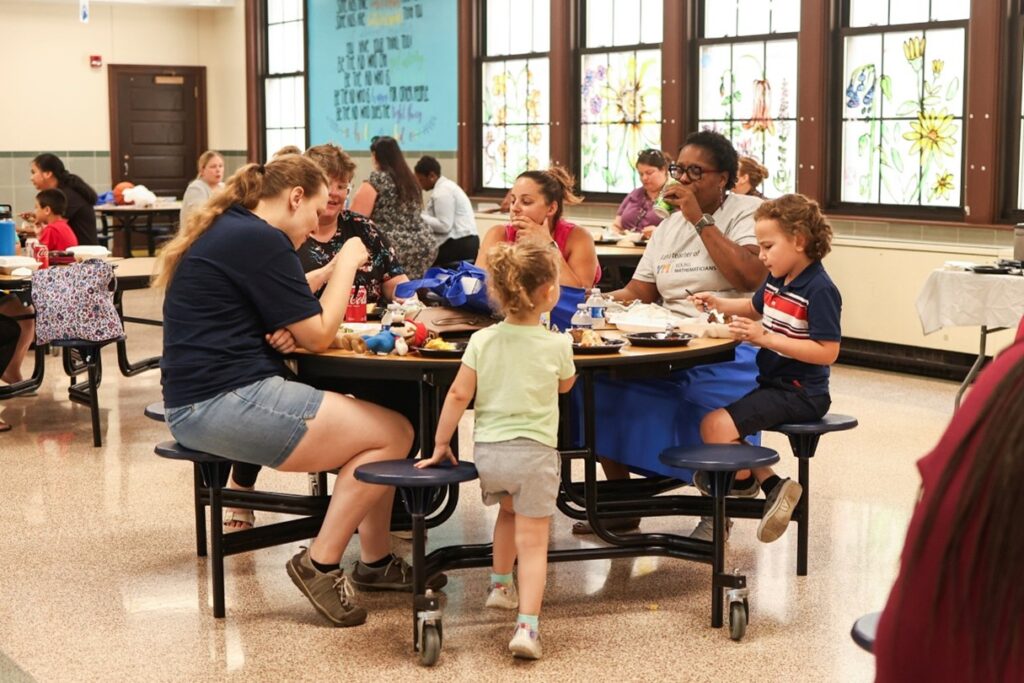Improved levels of academic achievement and healthy social-emotional development for students are among the many benefits of strong family-school partnerships. At the October First 10 Network Meeting, EDC’s Jenny Portillo-Nacu, Senior Team Facilitator for First 10, and Kristen Reed, Managing Director for Young Mathematicians, led a presentation on building strong family-school partnerships.
Through strong partnerships with families, school and district staff gain a better understanding of local needs and see an improvement in attitudes toward their schools when there is strong partnership with families. Effective family engagement practices help turn schools into community hubs for families where they can make connections while also gaining a better understanding of the school system and how to access support services. Families also see improvements in their social-emotional and mental wellbeing when they are connected to their children’s schools. When we treat family engagement as a systemic process that is present throughout a child’s life, rather than a series of isolated events, the impact of these benefits for students, staff, and families increases (Weiss, Lopez, & Rosenberg, 2010).
Portillo-Nacu and Reed also highlighted that families bring a wealth of assets to the table that can support their children’s academic success and social-emotional development. These assets are often referred to as Funds of Knowledge (Vélez-Ibáñez & Greenberg,1992; Gonzalez, Moll, and Amanti 2005). These assets, however, can often go unnoticed or unutilized to support student learning and development in schools. First 10 Network Meeting attendees reflected on what the term family engagement means to them and what mindsets they might hold about what family engagement should look like in schools. Educators often have expectations for families that are not explicitly communicated, and they may not consider the ways in which families can and want to engage with schools. When educators unpack their beliefs and mindsets, they are better equipped to connect with families about their assets and capacity to support their children in ways that are culturally responsive and affirming. Unpacking mindsets and beliefs can also help educators identify barriers to family engagement that can unintentionally keep us from leveraging the families’ assets. Taking an asset-based approach pushes educators to reframe family engagement as a shared responsibility led by schools rather than being the responsibility of individual families (Weiss, Lopez, & Rosenberg, 2010).
A key question that educators might have is “where do I start in order to build strong family partnerships?” Portillo-Nacu and Reed encouraged First 10 Network Meeting attendees to begin by learning from and about families. Some ways schools can learn more about families include listening sessions, surveys, and self-assessment rubrics to assess existing family engagement practices. Regardless of the method used, schools should aim to learn about what families want and need, as well as what assets families possess that can support their children’s learning and development. Like educators, families also need capacity-building to help them connect to better engage with their child’s school. Educators should connect with families to learn more about what this capacity-building for families should look like and the content that should be covered.
Network attendees had the opportunity to delve into two tools that they could leverage to learn more about the families they serve: the Panorama Education Family-School Relationships Survey and the Moving Toward Authentic Family Partnership Rubric. These are among the many tools that First 10 is assessing and will be sharing to support family partnerships.
The Family-School Relationships Survey is available in multiple languages and includes 10 scales on different dimensions of family-school relationships including family support and barriers to engagement. This survey can be used as a needs assessment and customized with specific scales that schools want to assess. When administering the survey, schools must be intentional about communicating why the survey is being given to families and how they will use the data gathered. Schools will also need to consider how to make the survey accessible for families with varying literacy levels and limited access to the internet if the survey is administered online.
The Moving Toward Authentic Family Partnerships Rubric is from the 2023 book, On the Same Team: Bringing Educators and Underrepresented Families Together by Ari Gerzon-Kessler from the Boulder County School District in Colorado. This rubric includes four domains related to family engagement: two-way communication; relationships and trust; learning and wellbeing; and decision making and power. Teams representing different roles and a diverse array of identities can collectively rate their school’s practices for each domain. The rubric can help school teams identify areas of strength and areas in need of improvement to move toward authentic family partnerships.
Schools and families are on the same team when it comes to supporting a child’s learning and development. Whether schools have established family engagement practices or are just developing their approach to partnering with families, a critical step is to intentionally listen to families.
